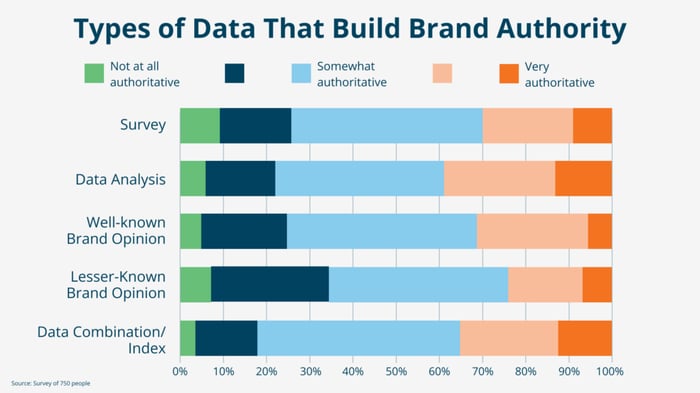Brand Authority: The Definitive Guide [2023]
Ever wonder how some brands just get it? Why they’re the ones we trust, while others fade to the background?
2023 is zooming by, and guess what? Building brand authority isn’t just a trend — it’s a must-have. Ready to make your mark? Dive in as we unpack the why and give you a roadmap with six solid steps to take the lead.

Manage all your social media accounts in one place.
Craft, schedule, & auto-post content to all your social channels, then track analytics and manage interactions from a single, easy-to-use dashboard.
What is brand authority?
Picture your brand, not just as another name, but as the go-to guru everyone turns to.
Here’s what it looks like:
- Expertise: You’re not just in the know, you’re THE know. Everyone hangs on your every word.
- Quality: Your products? They don’t just work — they’re the talk of the town, setting a pace that others race to catch up to.
- Trust: Your brand’s word isn’t just a word; it’s a promise. One that everyone believes in.
Combine these gems, and boom! You’ve got a brand that’s not just surviving, but thriving.
Time to dive in and elevate your brand to its awesome potential.
For example, Tesla has brand authority in the electric car industry.

Ever wonder how Tesla became, well… Tesla? It’s not just about snazzy cars. Their brand message and name have become shorthand for innovation. People don’t just want a Tesla; they dream of one.
And other car companies? They’re busy playing catch-up.
The same is true in different scenes:
- Google has brand authority for search engines.
- Tiffany’s has brand authority for jewelry.
- Rolex has brand authority for watches.
- Nike has brand authority for sportswear.
It’s not just about being the industry’s top pick. It’s about being the choice for each individual customer. Say someone walks into a Tesla showroom and gets a cold shoulder.
Or maybe they just didn’t vibe with the Tesla driving experience. That could easily make them lean more BMW or Nissan.
The cool part? Brands, including yours, have the steering wheel here. Focus on building a stellar brand experience, and watch perceptions shift your way.
Stay tuned! We’re diving into why this brand-building stuff is a game-changer for 2023 and the goodies that come with it.
The power of brand authority in 2023 (and beyond)
If you recall, we recently dived deep into the marketing trends of 2023. And guess what stood out? Your brand isn’t just a fancy logo or a catchy slogan. Think of it more as your secret superpower!
Want to gear up your business for not just making it, but rocking the future? One word for you: Authority.
By harnessing unrivaled know-how and expertise, you can transform your brand from just another name in the crowd to the one everyone’s buzzing about. Ensure that everything you serve up shouts “quality” from the rooftops.
Lastly, when your customers part with their cash? Make sure they’re thinking, “Wow, this is totally worth it!”

Research shows that customers who trust a brand are more likely to:
- Remain loyal
- Recommend them to friends
- Buy more products and services
- Buy more frequently
- Spend more money
- Share their experiences
Research shows that 66% of consumers would gain trust in a business if that business were transparent about how they used their personal data.
Brand authority and the foundation of trust it’s built on can help you to:
- Promote brand loyalty
- Prevent (or promote) brand switching
- Foster brand integrity
All of these can establish you as the go-to brand in your niche and ensure you have a profitable customer base in years to come. (It will also have your competitors quaking in their boots!)
But what steps do you need to take to establish brand authority?
Let’s take a look.
6 steps to build brand authority in 2023
Being unique is the superpower in today’s branding world. So, carve that special spot for yourself, making waves where others haven’t. Put your own spin on everything you say, letting it hit just the right notes.
And, oh! It’s not all about racking up sales. It’s about standing tall and proud for what you truly believe in. Supercharge your brand with content that’s not only catchy but truly, genuinely you.
Also, a little pro tip? Teamwork makes the dream work. Pair up with like-minded brands, mix those strengths, and see the magic unfold.
Follow this recipe, and before you know it, you’ll be that brand. You know, the one everyone’s talking about for all the right reasons!
1. Carve out your niche
Step into the world of brand authority by first anchoring yourself in a powerful niche. It’s that unique corner of the market where your expertise shines brightest.
And here’s the magic: when you position yourself in that precise spot, you lay the foundation for a voice that’s unmistakably clear and commanding.
For example:
- Volvo operates in the “motor” industry, but they are in the “safety” niche
- Oura operates in the “health” industry, but they are in the “sleep tech” niche
- Mont Blanc operates in the “stationery” industry, but they are in the “luxury pens” niche
Their authority stems from their ability to confidently create products, services, and content for their chosen niche.
That is why Volvo can create campaigns that talk about auto safety and campaigns that talk about making cities safer for women.
The niche you choose can be an existing one or a space you carve out for yourself.
Whatever you decide, it should:
- Resonate with your target audience
- Align with the products you offer
If you struggle with this, it can help to look at the reason why you are in business; the core driver behind what you do.
To explore those previous examples again, this could be:
- Volvo wants to make driving safer
- Oura wants to change the way we sleep
- Mont Blanc wants to preserve the writing experience
You can then extrapolate this “why” into the niche you will operate in.
2. Establish your brand voice
The next step is to look at how you communicate with your customers.
Your brand voice plays a pivotal role in this. We can consider a brand voice to be what you say and how you say it.
Your choices here will be heavily influenced by your industry, your niche, your audience, and the type of authority you want to become.
For example, Innocent, a UK-based drinks company, chose to establish a friendly and informal brand voice. It was conversational and felt like an interaction with a friend.
Their brand voice made them approachable to customers. But it also had a subconscious effect.
The simplicity of their voice reinforced the simplicity of their drinks, like this simple-but-effective
Instagram post about their green smoothie:
This type of brand voice was perfect for them in the health food niche. Why?
Previously, health food drink brands employed confusing jargon, made exaggerated health promises, and inundated customers with excessive information.
Innocent’s brand voice was the perfect antidote to this, and it allowed them to become an authority in their niche quickly.
This also spawned many imitators who copied their brand messaging style but with much less success — a true sign of brand authority.
Your brand voice should reinforce the trust, quality, and expertise of your brand. It should be a subtle reminder of what you stand for and how you will impact your customers.
Speaking of which…
3. Stand for something (and deliver on it)
Customers trust the brands they associate with, which get them and stand for similar ideals.
Research shows brands committed to social values are more likely to develop more trust than their counterparts. This is especially true if you target Millennials or Gen X.
So, take a stand and work hard to deliver on it.
Lush is an excellent example of this. They are a social issue-driven cosmetics company with clear stances on many of today’s hot political topics.
Their core message, though, has always been against animal testing. There is a clear anti-animal testing policy on their official website:

Lush also creates products — such as tote bags — that help promote the cause and offer a guarantee that no animals were harmed in making their products.
They have clearly defined a niche. They’ve curated a strong brand voice, taken a clear stand, and created a quality product that delivers on it.
You can create this authority for your brand even if you choose not to work on social issues. You can just as easily choose an issue relevant to your niche, such as:
- Better customer service
- Improved transparency
- Lower prices
- Reduced fees
If it is a real problem you are committed to helping your customer solve, it can be an effective part of your branding strategy.
4. Create good content
Content marketing is a powerful way to build brand authority.
You can deliver real value and leave a lasting impression on your audience while reinforcing your brand voice and message.
Content can take many forms, including:
In 2023, we predict we will see a large increase in the use of rich media content (the ones we have bolded in the above list). Why?
Because they allow you to expand and reach your audience in new and exciting ways. This dynamic storytelling can help you positively increase your brand authority.
Whatever medium you use, the end goal is to effectively communicate ideas, thoughts, trends, and solutions that are relevant to your industry.
5. Share a consistent message
Brand consistency is key in today’s digital world.
Research shows that brand consistency is a crucial factor in how customers choose a brand to buy from.
Consistency sets expectations and fosters trust. Being consistent equates to reliability, and being reliable means being trustworthy.
To do this, you must repeatedly reinforce:
- Who you are
- What you do
- What you stand for
Across all touchpoints in the customer journey, these include (but are not limited to) your:
- Content channels
- Customer service
- In-store experience
- Official website
- Social media feeds
If you want to learn more about brand consistency and how to establish it, we recommend you read our Ultimate Guide to Brand Consistency.
6. Collaborate with the right brands and influencers
Collaboration is king.
We predict, thanks to changes in technology and how brands operate, that collaborative marketing is going to be paramount in the next decade. Why?
Because there are lots of benefits to aligning yourself with the correct brands or influencers.
When you partner with another high-profile brand to offer a unique product, service, or experience, you create positive brand associations.
You can tap into their existing audience and utilize some of their brand authority to grow your own. When you are seen with that brand, you are further legitimized as an authority.
For example, Adidas has been able to increase its brand authority with streetwear customers and competitors through partnerships with hip-hop artists like Kanye West (YEEZY), Run DMC, and Big Sean.
We have also seen this happen with brands like Netflix and Baskin Robbins, Chubbies and Star Wars, and Sonos and IKEA.
You can read more about collaborative marketing and how it can grow your brand authority in our Definitive Guide to Collaborative Marketing.
Pillars of brand authority
By now, you should understand that establishing brand authority is essential. So, let’s explore the foundational pillars that contribute to a brand’s credibility and trustworthiness below.
Pillar 1: Leverage social media
Brand authority isn’t just a flashy term; it’s the ticket to visibility, trust, and exponential growth. If you’re a social media manager, part of an SMB, or run a small marketing agency, you know the importance of standing out in a sea of digital noise.

So, how can social media serve as your secret weapon? Let’s break it down:
Leverage influencer collaborations
Think influencers are just for the big brands? Think again. Brands, especially SMBs, are turning to micro-influencers, seeing a rise in engagement rates. It’s not just about reach anymore; it’s about genuine, cost-effective connections.
Ensure prompt and meaningful engagement
Gone are the days of posting and ghosting. In 2022, social media emerged as the top channel for brand recognition. But the brands that listen, respond, and engage truly reap the rewards. The data shows that brands actively engaging with their audience witness a 45% uptick in brand recall.
Utilization of user-generated content (UGC)
Why craft content when your fans are doing it for you? UGC not only offers fresh, authentic content but also boosts credibility. Brands leveraging UGC see a 20% increase in return on ad spend.
Look no further than Adobe for a masterclass on brand authority via social media. Their intelligent use of influencer collaborations, active audience engagement, and spotlight on UGC positions them as a market leader.
Their strategy isn’t just about showcasing products; it’s about community building and industry leadership. Take a leaf from their book, and you can pen your brand’s success story.
Pillar 2: Tap the power of client testimonials
You know when a friend can’t stop talking about their latest find? That’s kind of the magic your brand needs. When potential customers see glowing feedback from happy users, it’s like adding a stamp of approval to your brand.

Testimonials? They’re basically your brand’s cheerleaders, giving that extra boost of trust and authenticity.
Steering customer decisions
You know that nudge you sometimes need before trying something new? Turns out, hearing good things from others often does the trick. It’s a little secret of ours — we all like a bit of reassurance.
For brands, testimonials are that magic tool. Highlighting happy stories from actual users? It’s like giving potential customers a friendly wink and saying, “Hey, come join the fun!
The magic of video testimonials
Think of a written testimonial as a friendly wave, but a video testimonial? That’s like a genuine high-five. Videos catch those real-deal moments — the spark in a satisfied customer’s eyes or that big smile after things just click.
There’s something about seeing those true feelings that just grabs you. And let’s face it, in our swipe-and-scroll world, a snappy video can tell a story that sticks.
Bottom line? If boosting trust is your goal, it’s time to roll out those video testimonials. They’re not just telling tales; they’re broadcasting big-time belief in your brand.
Pillar 3: Optimize your website
Ever stepped into a place and just thought, “Wow, they’ve got their act together”? Everything’s spot on, welcoming, and just screams ‘top-notch’?

That’s what your website should do in the online universe. It’s like your brand’s digital handshake. A killer design, smooth sailing (aka easy navigation), and those little thoughtful touches make all the difference in how folks see your brand.
Quality content is king
Your website is more than just a pretty face; it’s a content powerhouse. Offering well-researched, valuable, and high-quality content can elevate your brand from being “just another player” to a thought leader in your niche.
Such content not only garners trust but also cultivates unwavering customer loyalty.
SEO — Your golden ticket
Ever stumbled on an awesome place but wondered, “How did I miss this before?” Your website might be fantastic, but without SEO, it’s like a great song that never gets airplay. Pump up the SEO, and watch your website shine in the search results!
Climbing those search ranks? That’s like getting a virtual high-five! It’s the internet’s way of saying, “Hey, this place is cool!”
Consistency is key
Ever met someone with a strong personal brand? They’re consistent in how they present themselves, right? Your website should embody the same principle. Consistent branding elements — from logo placement and brand colors to messaging tone — weave a cohesive story.
This alignment with your company’s mission and values not only boosts recognition but shouts authority from the digital rooftops.
To sum it up, an optimized website isn’t just a digital placeholder; it’s your brand’s authoritative handshake in the virtual realm.
Pillar 4: Transition from brand authority to brand loyalty
Think of brand authority as the solid ground and brand loyalty as the awesome party happening on it. First, you’ve gotta be the go-to guru in your field (that’s your authority).

Once people trust you’re the real deal, they’ll keep coming back for more (hello, loyalty!).
Trust as the cornerstone
An authoritative brand is akin to that mentor everyone wants advice from — revered, trusted, and looked up to. This established authority is a beacon of reliability, and when customers trust a brand, their instinctive loyalty to it follows suit.
In essence, brand authority nurtures the roots from which loyalty blossoms.
Consistency in quality and value
A loyal fanbase isn’t built overnight. To transition from mere authority to unwavering loyalty, a brand must consistently deliver quality and value.
Brands that continually meet and even exceed customer expectations bolster positive perceptions and loyalty.
Customer service: The silent MVP
Ever had a negative issue turned around by exceptional customer service? Such moments solidify loyalty. Brands that prioritize their customers address concerns promptly and consistently go that extra mile to foster a community of satisfied, loyal patrons.
Forging emotional bonds
Beyond transactions and interactions, the most loyal customers are those emotionally tethered to a brand. Whether it’s resonating with a brand’s story, aligning with its societal causes, or feeling valued through personalized engagements, these emotional connections are the lifeblood of loyalty.
While authority positions a brand as a leader, it’s the ensuing trust, consistency, customer-centricity, and emotional bonds that create loyal followers.
Brand authority in a nutshell
If you’re looking to build brand authority, social media, client testimonials, and a stellar website are your trifecta.
But here’s the fun part: while authority is your ticket in, loyalty is what keeps the party going. Trust, top-notch quality, and genuine connections? That’s the secret recipe to make your fans feel like they’ve found their online hangout spot. Cheers!



